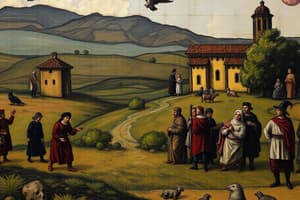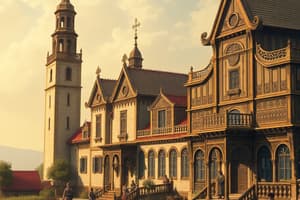Podcast
Questions and Answers
Which of the following groups were a part of the Migration Period?
Which of the following groups were a part of the Migration Period?
- Goths (correct)
- Celts
- Greeks
- Vikings
The 5th-century massacre at the fort in Öland involved primarily warriors.
The 5th-century massacre at the fort in Öland involved primarily warriors.
False (B)
What significant environmental change affected the Vikings in Greenland?
What significant environmental change affected the Vikings in Greenland?
Climate change causing a drying trend.
Mass graves at Öland provided evidence of a ______ and brutal attack.
Mass graves at Öland provided evidence of a ______ and brutal attack.
Match each effect with its cause related to the Vikings in Greenland:
Match each effect with its cause related to the Vikings in Greenland:
What was a significant technological development for the Vikings in the later Viking age?
What was a significant technological development for the Vikings in the later Viking age?
Vikings established several large cities during their age of expansion.
Vikings established several large cities during their age of expansion.
What was the primary labor source for building Viking ships during the later Viking age?
What was the primary labor source for building Viking ships during the later Viking age?
The introduction of the sail in the 700s was important, but it was not the sole __________ for Viking exploration.
The introduction of the sail in the 700s was important, but it was not the sole __________ for Viking exploration.
Match the following locations with their significance during the Viking Age:
Match the following locations with their significance during the Viking Age:
Flashcards
Migration Period
Migration Period
The period from the 4th to 8th centuries AD, marking the decline of the Western Roman Empire and the movement of various groups, like Goths and Vandals, into former Roman territories, laying the groundwork for medieval Europe.
Öland Massacre
Öland Massacre
A 5th-century violent attack at a fort in Öland, Sweden, leaving 26 people (men, women, children) unburied, revealing a brutal event and the immediate aftermath, potentially during the migration period.
Greenland Viking Disappearance
Greenland Viking Disappearance
The probable cause of the Greenland Viking's disappearance as due to a combination of a drying climate leading to water scarcity for agriculture and the adaptation limitations of the Vikings.
Climate Change Impact on Vikings
Climate Change Impact on Vikings
Signup and view all the flashcards
Historical Formation of 'New Worlds'
Historical Formation of 'New Worlds'
Signup and view all the flashcards
Viking Age Shipbuilding
Viking Age Shipbuilding
Signup and view all the flashcards
Later Viking Economy (900-1050)
Later Viking Economy (900-1050)
Signup and view all the flashcards
Viking Ship Construction Cost
Viking Ship Construction Cost
Signup and view all the flashcards
Viking Era Slavery
Viking Era Slavery
Signup and view all the flashcards
Viking Age Cities
Viking Age Cities
Signup and view all the flashcards
Study Notes
Migration Period
- Lasted from the 4th to 8th centuries AD, before the Viking Age.
- Marked by the decline of the Western Roman Empire.
- Included various groups like Goths, Vandals, Huns, Franks, Angles, Saxons, Lombards, and Slavs.
- Led to the foundation of medieval European kingdoms, blending Roman and "barbarian" traditions.
- Population pressures and the appeal of former Roman territories were significant factors.
- Set the stage for the medieval period and the Viking Age.
5th-Century Massacre in Öland, Sweden
- 26 individuals (men, women, and children) were victims of a sudden, brutal attack.
- Victims' bodies were left unburied within the fort.
- This provided a unique perspective on the event and its aftermath.
- High-quality artifacts, like gilded silver brooches and Roman glass, suggest affluent inhabitants involved in trade.
- Imported goods and the fort's strategic location indicate Öland served as a hub for migration and trade.
Greenland's Vikings' Disappearance
- Sediment cores suggest a drying trend during the Norse occupation, affecting water for agriculture and livestock.
- Droughts reduced hay production, leading to food shortages for livestock.
- The Norse adapted by hunting seals, but the drying climate made even that unsustainable.
- The Vikings' vulnerability to climate variability highlights the need for sustainable resource management.
Later Viking Age (AD 900-1050)
- New technologies and economic systems emerged.
- A golden age for sheep farming.
- Longships improved in speed and shallower drafts.
- The introduction of the sail, but not the sole factor driving Viking Age expansion.
- Building a single ship took two years and 10-hour work days.
Sheepscape (Ladby Ship)
- Located in Denmark, it's an archaeological site.
- Crew size: 32 individuals.
- Linen fabrics suggest sheep rearing.
- Equipping a Viking fleet of 200 ships required the year's work of 30 people.
- Reorganization of the economy was necessary to support Viking operations.
- Millions of sheep were kept.
Timber, Sail, and Labor (Skuldelev 2 Ship)
- 2,650 person-days were required to build a ship.
- A 2 km rope and a 120 sq m sail were needed.
- Access to forested land was managed.
- Enslaved women worked in weaving huts.
- Raiding was instrumental in obtaining slaves.
Cities in the Viking Age
- Constantinople (Istanbul) had a large population of 500,000 in the early medieval period.
- London was a Roman city.
- Lundenwic became a vital port city.
- London was refounded by King Alfred the Great.
- Smaller market towns, like Ribe, existed.
- Multi-lingual communities were common.
Studying That Suits You
Use AI to generate personalized quizzes and flashcards to suit your learning preferences.




